I am plotting a regression line with equation for a time series data: however it does not look correct. what could be the issue?
code:
p1<-ggplot(df2,aes(x=date_his,y=his))+geom_line(lwd=0.8)+
scale_x_date(date_labels = "%Y",expand = c(0, 0))+
theme(plot.title = element_text(size = 14, hjust = 0.5))+
geom_smooth(method = "lm", se = FALSE, linetype = "dashed", color = "blue", size = 1.2)+
ggpubr::stat_regline_equation(label.x = -Inf, label.y = Inf, vjust = 1.5, hjust = -0.1, size = 5,color = "blue",
formula = y ~ poly(x, 1),
show.legend = FALSE
)
the summary of the regression:
summary(lm(his ~ date_his, data = df2))
Call:
lm(formula = his ~ date_his, data = df2)
Residuals:
Min 1Q Median 3Q Max
-9.5030 -3.7714 0.0661 4.0350 8.2860
Coefficients:
Estimate Std. Error t value Pr(>|t|)
(Intercept) 1.682e+02 2.246e+00 74.889 < 2e-16 ***
date_his -6.247e-04 2.138e-04 -2.922 0.00614 **
---
Signif. codes: 0 ‘***’ 0.001 ‘**’ 0.01 ‘*’ 0.05 ‘.’ 0.1 ‘ ’ 1
Residual standard error: 4.867 on 34 degrees of freedom
Multiple R-squared: 0.2007, Adjusted R-squared: 0.1772
F-statistic: 8.538 on 1 and 34 DF, p-value: 0.006141
df2 <- data.frame(
date_his = as.Date(c(
"1979-04-28", "1980-04-28", "1981-04-28", "1982-04-28", "1983-04-28",
"1984-04-28", "1985-04-28", "1986-04-28", "1987-04-28", "1988-04-28",
"1989-04-28", "1990-04-28", "1991-04-28", "1992-04-28", "1993-04-28",
"1994-04-28", "1995-04-28", "1996-04-28", "1997-04-28", "1998-04-28",
"1999-04-28", "2000-04-28", "2001-04-28", "2002-04-28", "2003-04-28",
"2004-04-28", "2005-04-28", "2006-04-28", "2007-04-28", "2008-04-28",
"2009-04-28", "2010-04-28", "2011-04-28", "2012-04-28", "2013-04-28",
"2014-04-28"
)),
his = c(
166.008140637138, 169.867917428802, 157.525649715296, 172.567833065154,
170.267019131607, 168.725866057929, 166.718135941998, 158.34217326036,
157.493444169524, 164.212162698115, 161.140482761292, 161.851683272819,
158.688162091076, 159.249075294438, 153.373329948267, 170.934314928049,
164.557361076648, 169.910429608586, 163.399094199897, 161.238272986288,
166.19105244493, 162.451935740926, 157.307524920014, 164.886371717477,
153.843986514936, 157.656023562196, 164.433730558708, 165.485611515611,
157.622007235028, 165.006218026182, 161.901572985301, 152.963472898683,
154.013037508575, 156.507409368617, 157.244735400283, 161.214916194711
)
)
